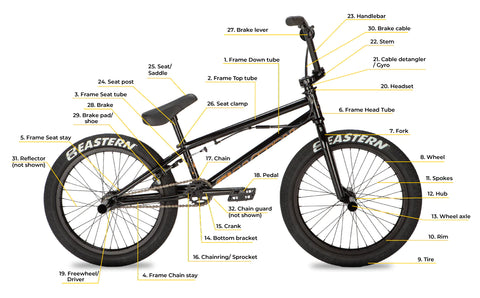Welcome to our comprehensive guide on the anatomy of a BMX bike. Whether you're a seasoned BMX rider or just getting started, understanding the components of these high-performance machines is crucial for optimizing your riding experience. In this article, we'll take a deep dive into the key parts that make up a BMX bike, exploring their functions, variations, and how they influence performance. So let's gear up and explore the exciting world of BMX bike components!

-
Frame: The frame is the backbone of a BMX bike, providing strength, stability, and durability. We'll discuss the different materials used in frame construction, such as chromoly steel and aluminum, and their respective advantages. Explore frame geometry and how it affects maneuverability, stability, and specific riding styles.
-
Forks: Forks play a crucial role in a BMX bike's handling and control. Learn about the various fork designs, such as straight and tapered, and their impact on responsiveness. Discover the different fork materials, such as carbon fiber and chromoly, and how they balance weight and strength.
-
Wheels and Tires: Uncover the secrets behind BMX wheels and tires. Delve into the importance of wheel size, spoke count, rim materials, and hub configurations. We'll also discuss tire treads, widths, and pressures, and how these factors affect traction, speed, and maneuverability on different terrains.
-
Handlebars and Grips: Handlebars are your connection to the bike, and finding the right style and size is crucial for comfort and control. Explore different handlebar types, including riser bars and BMX racing bars, and their intended uses. We'll also cover grip materials, patterns, and their impact on hand comfort and slip resistance.
-
Cranks and Pedals: Discover the power behind your pedals. Learn about BMX cranks, their lengths, and how they influence your pedalling efficiency and ground clearance. Dive into pedal types, such as platform and clipless pedals, and the pros and cons of each.
-
Brakes: Braking is an essential aspect of BMX riding, ensuring safety and control. We'll explore different brake systems, including U-brakes and disc brakes, and their effectiveness in various riding styles. Discover brake pad materials and how they impact stopping power and modulation.
-
Drivetrain: The drivetrain is the heart of a BMX bike, transferring power from your legs to the wheels. We'll discuss chainring sizes, gear ratios, and the impact on acceleration and top speed. Learn about freewheels, cassettes, and hub driver mechanisms, and their role in BMX riding.
Conclusion:
Understanding the anatomy of a BMX bike is crucial for riders of all skill levels. By grasping the function and importance of each component, you'll be better equipped to optimize your ride, enhance performance, and choose the right upgrades or replacements. Whether you're a street rider, park enthusiast, or racing fanatic, exploring the world of BMX bike components will deepen your appreciation for these adrenaline-pumping machines. So get out there, hit the tracks, and experience the exhilaration of BMX riding to the fullest!
Remember, for a wide range of high-quality BMX bikes and components, visit BuySkates.co.uk. Our expert team is here to assist you in finding the perfect setup for your BMX adventures. Happy riding!
